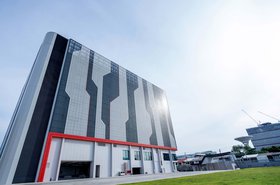Whether we like it or not, the data center industry is going through some pretty monumental shifts. Demand is bigger than ever, and the drive to meet this demand is following suit. But with mass consumption, comes massive concern.
“We've gone from zero to data center dominance in a short period of time. We've tapped some of our mechanical and electrical infrastructures in, but now with sustainability pressures, and the impact on the environment, we're struggling to look at new and innovative ways to get things done quickly.”
Sean Farney is the director of business and marketing for data centers with Kohler Power, and perhaps more importantly is a self-professed data center nerd. His enthusiasm is uncurbed.
“We're seeing a surge of devices; medical wearables, autonomous vehicles – what I call robots. The army of machines that is present in the industry, and even in your house, is increasing and 5G is an enabling technology, which will allow this to happen and flourish.”
“It is the new technology which is driving growth, and all of it needs power systems. In particular, it needs backup power systems, because things like medical wearables carry life-or-death information.”
The necessity of backup power for data centers is indisputable, but traditional diesel generators have a significant impact on the environment and desperately need innovating. We are living in a climate crisis that renders ignoring the impact of our industry impossible.
There is a certain irony to all of this, as climate change increases the likelihood of extreme weather events, which can have a dramatic impact on the functioning of data centers.
“Hurricanes do very bad things to electrical grids and power systems. Yet, thanks to the diesel generator, things kept running. Mission critical stuff is at stake in hospitals and critical care facilities, assisted living facilities, first responders, and were all kept running because of the generator. We owe it to this old technology, and we have got to keep that in mind when we're assessing the overall context of what we need to do and where we need to go with backup power.”
The very thing that contributes to the issue, is the thing that we turn to at the point of crisis. So, to avoid a never-ending cycle of destruction to the planet followed by damages to our data centers, are we to evolve or revolt?
“We [at Kohler] are going to take both a revolutionary approach and an evolutionary approach to solving this ESG and sustainability issue.”
“We're going to throw away diesel generators and replace them with new technology.”
“Hydrogen fuel cells are a replacement technology to provide backup power and remove diesel generators. A long-term generator replacement idea, with very low emissions, almost self-contained, with a very green output. There is still not a ton of work done yet around the disposal impact and creation impact, but we will get there.”
“I have got to give credit to these companies that are investing people and money into looking at different ways of doing things specifically to be more sustainable. For example, Google, which is carpeting the world with data centers, and looking into radical and new ways to potentially replace generators and obviate their emissions and carbon footprint impact around the world. For instance, large arrays of lithium-ion batteries powering entire data centers.”
In this way, we can uproot the basis of diesel power generators, with entirely new concepts and technologies, we can instigate a technological revolution.
But alongside this intellectual anarchy, we can look to evolve the existing technologies.
“Evolution can be grouped into three different areas: green fuels, green operations, and green maintenance. This is evolving stuff that we're doing today and have been doing for a long time. For example, hydrotreated vegetable oil-powered sites are running today. In the UK, they are transitioning and running sites on this vegetable oil. There's also a variant using byproducts from lumber or wood processing which has 90 percent lower Co2 emissions.”
We can even look to cool our facilities in very simple ways that use less energy.
“I recall from running a data center in Chicago that I had 270 days a year where I could use the outside air to help with cooling. In cooler climates, this is a possibility, and in low humidity environments. Humidity is really challenging with cooling a lot of times. Also, elevating ambient temperatures in our colo spaces and making servers run hotter to reduce power use is an old trick. But it works, and it does have an impact.”
So, we can do both. We can be a part of the revolution, while simultaneously actively evolving our current technologies. Most of these newer technologies are not yet in a position to be used en masse in the industry, but through dedicated research, we will get there, and possibly to a point where our data centers are not just carbon neutral, but carbon positive.
Watch the APAC episode by filling out the form below to learn more.
See more...
-

Telstra consortium to build digital twin of New South Wales to protect infrastructure during Australian wildfires
Helping maintain uptime in the next inevitable devastating fire season
-

Indian telco relief package approved, Vodafone Idea given breathing room
Company giving reprieve on billions of dollars owed for spectrum fees
-

STT GDC opens hyperscale data center in Bangkok
Largest data center in Bangkok is now open


